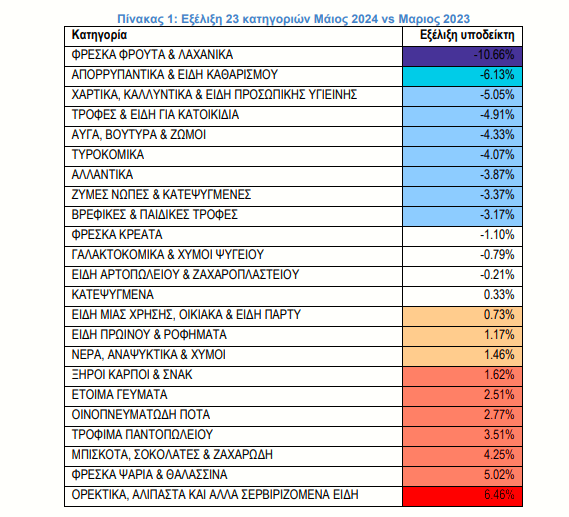Targeted research by the Consumer Goods Retail Research Institute (IELKA) exclusively in the channel of large supermarket chains regarding inflationary trends in organized food retailing
Decreased by an average of -1.92% compared to June 2023, the prices of products in supermarkets are recorded in June 2024 compared to June 2023 according to a targeted survey of the Consumer Goods Retail Research Institute (IELKA) exclusively in the large chain channel supermarkets on inflationary trends in organized food retailing. 12 of the 23 supermarket product categories recorded a decrease.
The following conclusions emerged from the research:
1. The net decrease in the June 2024 supermarket chain price index shows that supermarket chain inflation is negative at -1.92% (vs. -1.25% in May, +1.10% in April, + 0.28% in March, +2.70% in February and +3.00% in January 2024). June’s change is mainly due to continued price deflation and partly due to the effect of summer seasonality.
2. Larger price reductions are recorded in the following categories:
- Fresh fruits and vegetables: -10.66%
- Detergents and cleaning supplies: -6.13%
- Stationery, cosmetics and personal hygiene items: -5.05%
- Food and pet supplies: -4.91%
- Eggs and butter: -4.33%
Fresh fruits and vegetables have benefited from the comparatively better weather conditions compared to 2023. In the rest of the items, the decreases recorded are the result of both the normalization of the market after the pandemic and the decrease in producer prices for some products.
3. Larger increases are recorded in the categories:
- Appetizers, spreads and other served items: +6.46%
- Fresh fish and seafood: +5.02%
- Biscuits, chocolates, sweets: +4.25%
- Grocery: +3.51%
- Spirits: +2.77% Most of these items are affected by international raw material prices, sugar and cocoa prices and other production costs. Of the 23 categories examined, 13 recorded a decrease and 10 an increase.
4. The reasons attributed to the tendency to hold down product prices in supermarkets:
- Better than 2023 weather conditions in May 2024 and seasonality. Last year’s rains had significantly increased the cost of fresh fruit and vegetables. This year’s better weather conditions have reduced the prices of fresh fruits and vegetables by more than 10%. At the same time, the seasonality of the products in the category affects more the course of the overall index.
- Gradual deflation of inflation. Prices have been stabilizing in recent months in large grocery stores due to the large volumes of products they carry, economies of scale, their organizational/technological readiness and their private label product range.
- Government institutional interventions. Supermarket chains operate in a strict institutional framework (e.g. Prohibition of promotions in case of price increases 6969/2024).
- Offers and discounts. Offers and discounts in the organized retail channel are more in number, intensity and percentage discount, which affects the final prices of the products.
- The course of the prices of raw materials in the previous months in the international markets and the normalization of the market. International indices of food raw materials (e.g. FAO Food Price Index) record a decrease in the first months of 2024 in most cases. In cases like coffee and cocoa, however, the effect is reversed.
- High stock turnover rate. Price containment occurs much faster in large outlets due to higher inventory turnover. That is, they sell their stock faster and make new purchases to replenish stocks more quickly.
- Impact of private label products. Sales shares of private label products are greater in large supermarket chains due to a wider range of codes, and have been increasing over the past two years.
Source: Skai
I am Janice Wiggins, and I am an author at News Bulletin 247, and I mostly cover economy news. I have a lot of experience in this field, and I know how to get the information that people need. I am a very reliable source, and I always make sure that my readers can trust me.











